
USS Galena was a wooden-hulled broadside ironclad built for the United States Navy during the American Civil War. The ship was initially assigned to the North Atlantic Blockading Squadron and supported Union forces during the Peninsula Campaign in 1862. She was damaged during the Battle of Drewry's Bluff because her armor was too thin to prevent Confederate shots from penetrating. Widely regarded as a failure, Galena was reconstructed without most of her armor in 1863 and transferred to the West Gulf Blockading Squadron in 1864. The ship participated in the Battle of Mobile Bay and the subsequent Siege of Fort Morgan in August. She was briefly transferred to the East Gulf Blockading Squadron in September before she was sent to Philadelphia, Pennsylvania for repairs in November.

Atlanta was a casemate ironclad that served in the Confederate and Union Navies during the American Civil War. She was converted from a British-built blockade runner named Fingal by the Confederacy after she made one run to Savannah, Georgia. After several failed attempts to attack Union blockaders, the ship was captured by two Union monitors in 1863 when she ran aground. Atlanta was floated off, repaired, and rearmed, serving in the Union Navy for the rest of the war. She spent most of her time deployed on the James River supporting Union forces there. The ship was decommissioned in 1865 and placed in reserve. Several years after the end of the war, Atlanta was sold to Haiti, but was lost at sea in December 1869 on her delivery voyage.

USS Onondaga was an ironclad monitor built for the Union Navy during the American Civil War. Commissioned in 1864, the ship spent her entire active career with the James River Flotilla covering the water approaches to the Confederate States capital of Richmond, Virginia, although her only notable engagement was the Battle of Trent's Reach. After the war, she was purchased by France where she served as a coastal defense ship in the French Navy.

CSS Baltic was an ironclad warship that served in the Confederate States Navy during the American Civil War. A towboat before the war, she was purchased by the state of Alabama in December 1861 for conversion into an ironclad. After being transferred to the Confederate Navy in May 1862 as an ironclad, she served on Mobile Bay off the Gulf of Mexico. Baltic's condition in Confederate service was such that naval historian William N. Still Jr. has described her as "a nondescript vessel in many ways". Over the next two years, parts of the ship's wooden structure were affected by wood rot. Her armor was removed to be put onto the ironclad CSS Nashville in 1864. By that August, Baltic had been decommissioned. Near the end of the war, she was taken up the Tombigbee River, where she was captured by Union forces on May 10, 1865. An inspection of Baltic the next month found that her upper hull and deck were rotten and that her boilers were unsafe. She was sold on December 31, and was likely broken up in 1866.
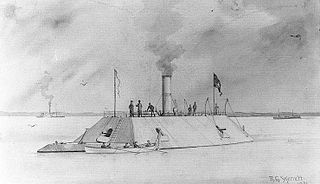
CSS Palmetto State was one of six Richmond class casemate ironclad rams built for the Confederate States Navy during the American Civil War. Completed in 1862, she defended Charleston, South Carolina and was burnt in 1865 to prevent her capture by advancing Union troops.

CSS Chicora was a Confederate ironclad ram that fought in the American Civil War. It was built under contract at Charleston, South Carolina in 1862. James M. Eason built it to John L. Porter's plans, using up most of a $300,000 State appropriation for construction of marine batteries; Eason received a bonus for "skill and promptitude." Its iron shield was 4 inches (102 mm) thick, backed by 22 inches (559 mm) of oak and pine, with 2-inch (51 mm) armor at its ends. Keeled in March, it was commissioned in November, Commander John Randolph Tucker, CSN assuming command.

USS Canonicus was a single-turret monitor built for the United States Navy during the American Civil War, the lead ship of her class. The ship spent most of her first year in service stationed up the James River, where she could support operations against Richmond and defend against a sortie by the Confederate ironclads of the James River Squadron. She engaged Confederate artillery batteries during the year and later participated in both attacks on Fort Fisher, defending the approaches to Wilmington, North Carolina, from December 1864 to January 1865.
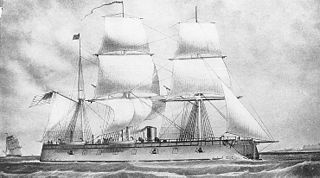
USS New Ironsides was a wooden-hulled broadside ironclad built for the United States Navy during the American Civil War. The ship spent most of her career blockading the Confederate ports of Charleston, South Carolina, and Wilmington, North Carolina, in 1863–65. New Ironsides bombarded the fortifications defending Charleston in 1863 during the First and Second Battles of Charleston Harbor. At the end of 1864 and the beginning of 1865 she bombarded the defenses of Wilmington in the First and Second Battles of Fort Fisher.

The first USS Montauk was a single-turreted Passaic-class monitor in the Union Navy during the American Civil War.
CSSIsondiga was a wooden gunboat that served in the Confederate States Navy during the American Civil War. Designed according to Matthew Fontaine Maury's plan to produce a large number of small vessels to swamp the Union blockade, Isondiga was one of only two or three of these Maury gunboats actually completed, and the only one completed as designed. The Maury gunboats project had been almost entirely cancelled in favor of ironclad production after the Battle of Hampton Roads. Isondiga was built in Savannah, Georgia, and was transferred to the Confederate Navy in January 1863 to begin the fitting out process. At this time, she was commanded by Lieutenant Joel S. Kennard.
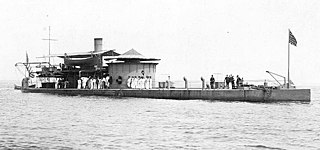
The first USS Nahant was a Passaic-class ironclad monitor of the United States Navy that saw service in the American Civil War and the Spanish–American War.
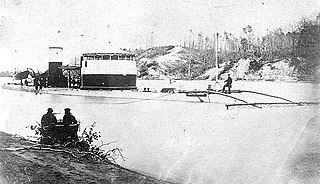
USS Saugus was a single-turreted Canonicus-class monitor built for the Union Navy during the American Civil War. The vessel was assigned to the James River Flotilla of the North Atlantic Blockading Squadron upon completion in April 1864. The ship spent most of her time stationed up the James River where she could support operations against Richmond and defend against a sortie by the Confederate ironclads of the James River Squadron. She engaged Confederate artillery batteries during the year and later participated in both attacks on Fort Fisher, defending the approaches to Wilmington, North Carolina, in December 1864 – January 1865. Saugus returned to the James River after the capture of Fort Fisher and remained there until Richmond, Virginia, was occupied in early April.
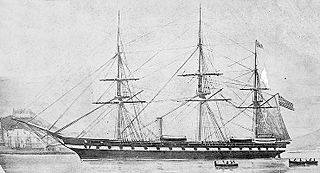
USS Roanoke was a wooden-hulled Merrimack-class screw frigate built for the United States Navy in the mid-1850s. She served as flagship of the Home Squadron in the late 1850s and captured several Confederate ships after the start of the American Civil War in 1861. The ship was converted into an ironclad monitor during 1862–63; the first ship with more than two gun turrets in history. Her conversion was not very successful as she rolled excessively and the weight of her armor and turrets strained her hull. Her deep draft meant that she could not operate off shallow Confederate ports and she was relegated to harbor defense at Hampton Roads, Virginia for the duration of the war. Roanoke was placed in reserve after the war and sold for scrap in 1883.

USS Neosho, the lead ship of her class, was an ironclad river monitor laid down for the Union Navy in the summer of 1862 during the American Civil War. After completion in mid-1863, the ship spent time patrolling the Mississippi River against Confederate raids and ambushes as part of Rear Admiral David Porter's Mississippi Squadron. She participated in the Red River Campaign in March–May 1864. Neosho resumed her patrols on the Mississippi after the end of the campaign. She supported the Union Army's operations on the Cumberland River and provided fire support during the Battle of Nashville in December 1864. Neosho was decommissioned after the war and remained in reserve until sold in 1873.

USS Osage was a single-turreted Neosho-class monitor built for the Union Navy during the American Civil War. After completion in mid-1863 by Edward Hartt, the ship patrolled the Mississippi River against Confederate raids and ambushes as part of Rear Admiral David Porter's Mississippi Squadron. Osage participated in the Red River Campaign in March–May 1864, during which she supported the capture of Fort DeRussy in March and participated in the Battle of Blair's Landing in April. The ship was grounded on a sandbar for six months after the end of the campaign and badly damaged. Osage, after being refloated and repaired, was transferred to the West Gulf Blockading Squadron in early 1865 for the campaign against Mobile, Alabama. During the Battle of Spanish Fort in March 1865 she struck a mine and rapidly sank. The ship was later salvaged and sold in 1867.
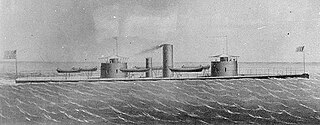
USS Monadnock was one of four Miantonomoh-class monitors built for the United States Navy during the American Civil War. Commissioned in late 1864, she participated in the First in December and Second Battles of Fort Fisher in January 1865. The ship was later assigned to the James River Flotilla on the approaches to the Confederate capitol of Richmond, Virginia and then sailed to Spanish Cuba to intercept the Confederate ironclad CSS Stonewall.

USS Manhattan was a single-turreted Canonicus-class monitor built for the Union Navy during the American Civil War. After commissioning in 1864 the ship was assigned to the West Gulf Blockading Squadron and participated in the Battle of Mobile Bay. At the end of the battle, Manhattan took the surrender of the Confederate casemate ironclad ram Tennessee. She bombarded Fort Morgan during the Siege of Fort Morgan and later blockaded the mouth of the Red River until the end of the war.

USS Mahopac (1864) was a Canonicus-class monitor built for the Union Navy during the American Civil War. The vessel was assigned to the James River Flotilla of the North Atlantic Blockading Squadron upon completion in September 1864. The ship spent most of her time stationed up the James River where she could support operations against Richmond and defend against sorties by the Confederate ironclads of the James River Squadron. She engaged Confederate artillery batteries during the year and later participated in both the first and second battles of Fort Fisher, defending the approaches to Wilmington, North Carolina, in December 1864 – January 1865. Mahopac returned to the James River after the capture of Fort Fisher and remained there until Richmond, Virginia was occupied in early April.

The First Battle of Charleston Harbor was an engagement near Charleston, South Carolina that took place April 7, 1863, during the American Civil War. The striking force was a fleet of nine ironclad warships of the Union Navy, including seven monitors that were improved versions of the original USS Monitor. A Union Army contingent associated with the attack took no active part in the battle. The ships, under command of Rear Admiral Samuel Francis Du Pont, attacked the Confederate defenses near the entrance to Charleston Harbor. Navy Department officials in Washington hoped for a stunning success that would validate a new form of warfare, with armored warships mounting heavy guns reducing traditional forts.
The Milwaukee-class monitors were a class of four riverine ironclad monitors built during the American Civil War. Several supported Union forces along the Mississippi River in mid-1864 before participating in the Battle of Mobile Bay in August. Chickasaw and Winnebago bombarded Confederate coastal fortifications during the battle and during subsequent operations as well as engaging the ironclad Tennessee II. The other two ships arrived at Mobile Bay after the battle and all four supported the land attacks on Mobile in March–April 1865. Milwaukee struck a torpedo during this time and sank. The surviving three ships were sold in 1874; Chickasaw was converted into a ferry and survived until 1944 when she was scuttled. Her wreck was discovered in 2004.






















